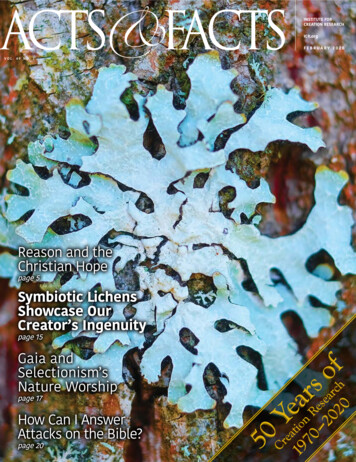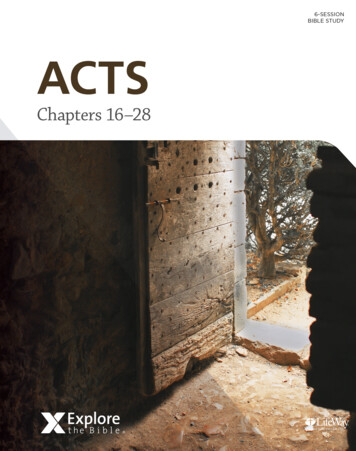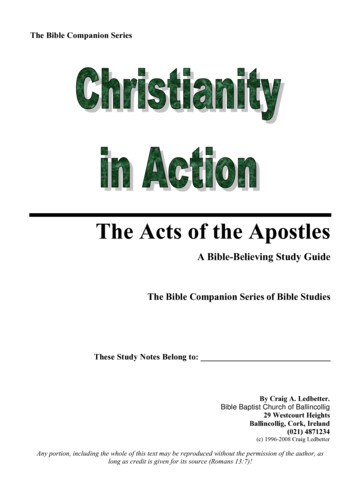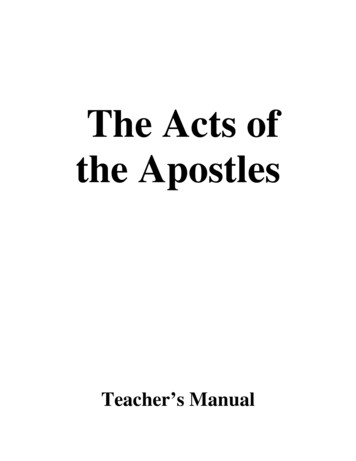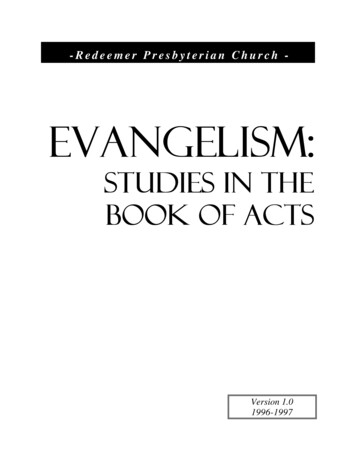
Transcription
ACTS&FACTSINSTITUTE FORCREATION RESEARCHICR.orgJ U LY 2 0 1 9VOL. 48 NO. 7For Such aTime as Thispage 5The Ark LandedWest of Mt. Araratpage 9Five Global Evidencesfor a Young Earthpage 10Intricate Animal DesignsDemand a Creatorpage 14
NEW!RETHINKINGRADIOMETRICDATINGEvidence for a Young Earth froma Nuclear PhysicistVernon R. Cupps, Ph.D. 24.99How old is Earth? Many believe it to be around 4.6billion years. This number is used so often that mostpeople accept it as a scientific fact. But are the datingmethods that appear to verify this age valid?With decades of experience in top nuclear physicslaboratories, ICR’s Dr. Vernon Cupps tackles thisquestion from a scientific and biblical perspective.Introductory Low Price!( 29.99 Retail)BRRD HardcoverHe examines the major radiometric dating methodsand the significant problems with the dating methodologycurrently employed by scientists.This first in a series of In-Depth Science books fromICR will show why Christians don’t need to rely on flawedscience to tell them about origins.THECLIMATE CHANGE CONFLICTKeeping Cool over Global Warming 2.99BY JAKE HEBERT, Ph.D.Climate change is a hot topic. From politics to theology, debate rages over whetherwe face an imminent climate catastrophe andwhether drastic action is needed to stop it.But how much is real science and how muchis just political alarmism?In The Climate Change Conflict: KeepingCool over Global Warming, Dr. Jake HebertCall 800.628.7640 or visit ICR.org/storeBTCCCdives into the confusing world of climatechange science and brings much-neededclarity from a scientific and biblical perspective.This booklet is a welcome introductionto the topic of climate change. Buy one foryourself and others to give away. Buy fiveand save 10%! Buy 20 and save 20%! Please add shipping and handling to all orders. Offer good through July 31, 2019, while quantities last.
VOLUME 48 NUMBER 7JULY 2019Published by5INSTITUTE FOR CREATION RESEARCHP. O. Box 59029Dallas, TX 75229214.615.8300featureICR.org5Acts & Facts is a free publication.H E N RY M . M O R R I S , P H . D .For subscription information,call 800.337.0375,researchvisit ICR.org/subscriptions,9or write to ICR at the above address.Jayme DurantBeth Mullimpact14EDITORSTruett Billupsback to genesisChristy Hardy14 Intricate Animal Designs Demanda CreatorDESIGNERDennis DavidsonJ E F F R E Y P. T O M K I N S , P h . D .No articles may be reprinted in whole or inCopyright 2019Institute for Creation Research10 Five Global Evidences for aYoung EarthJ A K E H E B E R T, P h . D .Michael Stamppart without obtaining permission from ICR.The Ark Landed West of Mt. AraratT I M C L A R E Y, P h . D .EXECUTIVE EDITORSENIOR EDITORFor Such a Time as This1515 Surprise! Deep-Sea Fish See ColorsBRIAN THOMAS, Ph.D.18 Engineered Features DetermineDesign Success or Failure, Part 2All Scripture quotations are from the New KingJames Version unless otherwise indicated.R A N D Y J . G U L I U Z Z A , P. E . , M . D .creation q & aFront cover image: Dragonfly. Image credit: Copyright 2013 Antagain. Used in accordance with federal copyright(fair use doctrine) law. Usage by ICR does not implyendorsement of copyright holder.20 Was the Global Flood Too Extreme?BRIAN THOMAS, Ph.D.20apologetics21 Moabite King’s Boast CorroboratesGenesisJAMES J. S. JOHNSON, J.D., Th.D.stewardship2122 Contend EarnestlyH E N RY M . M O R R I S I VJULY 2019 ACTS&FACTS 48 (7) ICR.ORG3
from the editorMilestonesIn this month’s feature article, “For Sucha Time as This” (pages 5-7), we see moments, snapshots in time, of the life ofICR founder Dr. Henry Morris: accepting Christ, going to Rice University, joining the Gideons, teaching Bible classes forcollege students, writing groundbreakingcreation books, moving cross-country withhis family to pursue God’s will, encountering opposition to creation teachings, andbeing instrumental in the beginnings ofseveral creation organizations, includingthe Institute for Creation Research. His decisions, circumstances, and opportunities,combined with God’s gentle guidance, led tomany changed lives over these past 50 years.I know this, because we often hearfrom you. Your emails, phone calls, letters,and social media comments are a source ofgreat encouragement to us. Thank you fortaking the time to let us know how ICR hasimpacted your lives!The challenges Dr. Morris faced in the1940s and ’50s are not very far from ourstoday. Regarding one scientific meeting heattended, Dr. Morris wrote, “I had thoughtthat since these scientists and theologiansprofessed to believe in the inspiration ofScripture, they would accept literal creationism and the worldwide Flood if they couldjust be shown that this is what the Bibleteaches.” He goes on to say, “I was wrong .That experience [of Christians rejecting evidence of the biblical account of creation] hasbeen repeated many times” (page 6). And westill see it today. ICR continues to hear fromthose who question a six-day creation, eventhough both the Bible and science confirm it.Since you’re reading Acts & Facts, I’massuming you have an interest in creationresearch. Perhaps God has some opportuni-4ICR.ORG ACTS&FACTS 48 (7) ties for you to help us get the creation message out. What’s the latest word we need tospread? The ICR Discovery Center for Science and Earth History is opening to thepublic September 2! The current update inthis month’s issue about the ICR Discovery Center shows you just how close weare (pages 16-17). This facility, dedicatedto sharing the truth about God’s work increation, wouldn’t be possible without you!Thank you for your prayers and sacrificialgifts that have enabled us to launch this newextension of ICR’s ministry.Just as Dr. Morris worked to share thescience that affirms the Bible, the DiscoveryCenter exhibits will reflect the research ofour scientists. You can find their thoughtson many biblical creation issues within thismagazine. Physicist Dr. Jake Hebert’s article,“Five Global Evidences for a Young Earth,”offers strong scientific arguments demonstrating recent creation (pages 10-13).Geneticist Dr. Jeffrey Tomkins shows how“God’s creatures are so intricate in form andfunction they must have been purposefullydesigned” (“Intricate Animal Designs Demand a Creator,” page 14), and paleobiochemist Dr. Brian Thomas showcases God’sdesign in deep-sea fish (“Surprise! Deep-SeaJULY 2019Fish See Colors,” page 15). Medical doctorand Professional Engineer Dr. Randy Guliuzza explains how it is better “to acknowledge the clearly seen design” in creatures and“consider the real superhuman power, intellect, and wisdom of the Lord Jesus Christ”(“Engineered Features Determine DesignSuccess or Failure, Part 2,” pages 18-19).These faithful creation scientists carryon the legacy of Dr. Morris, who went to bewith the Lord in 2006. As I read Dr. Morris’article, originally published almost 25 yearsago, I’m reminded how quickly time passes.Life-altering events come in a split second.Milestones are achieved and we move to thenext big challenge, need, or opportunity.With each change and new direction, Godcarefully and lovingly arranges the circumstances. And, as with Dr. Morris, He extendsour impact long after we leave this world.While you seek to make a difference in theworld, I hope you see His hand in the detailsof your life.Jayme DurantExecutive Editor
tsarticle highligh eni ng of the ICR Discov As we anticipate the opFor Such aTIMEas ThisTH E N R Yhis article sets forth the backgroundand mission of the Institute for Creation Research, as I have envisionedfrom the start. A key purpose of ICRis to bring the field of education—and thenour whole world insofar as possible—backto the foundational truth of special creationand primeval history as revealed in Genesis.The doctrine of special creation is basic inChristianity, and I trust that God has raisedup ICR to help meet this need.We expect to celebrate ICR’s 25th anniversary this year (1995–1996). God hasgreatly blessed the ministry, but the world’sneed in relation to the creation message hashardly been touched. Since I am nearing retirement, it’s important for the ICR familyto obtain a clear understanding of where we have been andwhere we are going if we aregoing to meet effectively thetremendous challenges of thedays ahead.Much of the ICR visionhas come out of my earlierstudy and experience.There’s still a great needfor at least one Christian educational center based on andframed around biblical revelation, especially the foundation of strict creationism.M .M O R R I S ,Earth History, it’s aery Center for Science andICR’s beginnings.good time to look back atM. Morris penned these ICR founder Dr. Henryroached its 25th anniwords in 1995 as ICR appevents leading up toversary. He reflected on theal need for a creationits founding and on the vitfocused ministry.nter will continue Dr. The ICR Discovery Cegenerations withMorris’ vision to reach newGod’s creation truth.PThis dream resulted from 35 years(1935–1970) as a Christian student, teacher,and administrator in five universities, alldominated by an evolutionary humanistic philosophy. Even though such a dreammay seem unrealistic, it represents a goal toward which Christians should aim. Today’syoung people will be the leaders of tomorrow in every field of human activity. Therecan be no more vital goal than to provide as many of them as possible witha solid biblical, Christian, creationisteducation.I accepted Christ at age 10through reading a Bible my mothergave me. This was during the Great Depression, but I was able to get into Riceh. D .University. Although I was a theistic evolutionist at that time, I could see even then thatthe teachings in science and the humanitieswere largely atheistic. I graduated in 1939with a degree in civil engineering and thenworked three years for the InternationalBoundary and Water Commission in ElPaso, dealing mostly with studies on the hydrology and hydraulics of river flood control.While in El Paso, my wife and Ibecame members of a good church, andI soon joined the Gideons. Throughthese I became convinced of the powerof God’s Word and the importance ofwinning people to Christ. In 1942, I wasasked to return to Rice as an instructor toteach engineering to Navy students whowere being trained as officers for the war.JULY 2019 ACTS&FACTS 48 (7) ICR.ORG5
featureBy then I was spending much time in theWord and soon started teaching a Bible classfor the students. I also began reading everybook I could find relative to science and theBible in order to answer the questions thestudents raised, especially about evolutionand creation.There was very little sound creationliterature available in those days, so I set outto write a small book myself that would helpwin skeptical young people to Christ andHis Word. That You Might Believe was firstpublished in 1946.When the war ended, I enrolled in thegraduate program at the University of Minnesota, majoring in hydraulics and minoring in geology and mathematics. I’d come torealize that the biblical Flood provided thereal key to harmonizing the scientific studyof Earth’s history with the Genesis recordand thus was the ultimate answer to evolutionism. The combination of hydraulics andgeology seemed the best preparation for effectively dealing with the great Flood in relation to science, and the University of Minnesota had the best combination of facilitiesand faculty for such study.I had to take a full-time instructorshipto support my family. TheLord led providentially inmany ways during thoseyears, enabling me to getboth the M.S. and Ph.D.degrees in record time. Anew edition of my bookwas brought out by MoodyPress in 1950—The Bibleand Modern Science—whichis still in print as Science andthe Bible. It was evidently thefirst book written by a scientist on a secular universityfaculty (at least in the 20th century) thatpresented evidence for recent creation andFlood geology.We then went to Louisiana, where Iserved six years as Head of the Civil Engineering Department at the University ofSouthwestern Louisiana. I continued the6ICR.ORG ACTS&FACTS 48 (7) library research and study I’d begun at Minnesota on geology and the biblical Flood,writing several chapters on what I hopedmight become a definitive work on biblicalcreationism and catastrophism. In 1953, Imet Dr. John Whitcomb at a meeting of theAmerican Scientific Affiliation (ASA) in Indiana. He’d read That You Might Believe as astudent at Princeton University and was oneof the very few men at that ASA meetingwho agreed with a paper I presented theretitled “Biblical Evidence for Recent Creationand the Worldwide Deluge.”I had thought that since these ASA scientists and theologians professed to believein the inspiration of Scripture, they wouldaccept literal creationism and the worldwideFlood if they could just be shown that this iswhat the Bible teaches.I was wrong. In the question period,they raised numerous scientific objectionsbut not one answer to the biblical evidencethat was absolutely compelling.That experience has been repeatedmany times since. The reaction to strictcreationism by Christian evolutionists andprogressive creationists is almost invariablyto defer to “science” rather than Scripture.They feel Christians shouldinterpret Scripture to conform to current scientificopinion rather than interpretthe scientific data in the context of biblical revelation.Such an attitude inanyone who professes tobe a Christian is dishonoring to God’s Word and tothe Lord Jesus Christ, whoHimself believed in recentcreation and the worldwide deluge.There has been a remarkable revivalof creationism in the past three decades.The Scopes Trial in 1925 resulted in such anoverwhelming media victory for the evolutionists that Christians as a whole seemed towant to ignore the entire controversial subject of origins.JULY 2019They no longer dared to questionthe evolutionary ages of the geologists, andmany Bible teachers tried to insert theseages into a postulated “gap” between the firsttwo verses of Genesis. Geologists, of course,could never accept this gap theory becausetheir “ages” were based on the assumption ofuniformitarianism, which has no room forthe global pre-Adamic cataclysm requiredby any such theory. The scientific and educational worlds gravitated to total evolutionism, while Christians concentrated on “personal Christianity.”At the great Darwinian Convocation at the University of Chicago in 1959,gathered to celebrate the 100th anniversaryof Darwin’s Origin of Species, evolutionistsfrom all over the world paid homage to Darwin, eulogizing him for delivering the worldout of what they thought was biblical bondage into evolutionary freedom. The keynotespeaker, Sir Julian Huxley, proclaimedthe complete triumph of evolutionary humanism,and other speakersurged the schoolshenceforth to center their curriculaaround the “fact”of evolution.It was at thatvery time thatJohn Whitcomband I were writing The Genesis Flood. Published early in1961, the Lord graciously used it as a catalyst to stir up the modern creationist revival.There had been a few attempts earlier toestablish an organized witness for scientificcreationism, but these had floundered. Thefailure was caused by divisive argumentsbetween strict creationists and those whowanted to accommodate the geological agesin their systems.These two systems are like oil andwater; they will never mix because they arefounded on two different premises. One believes Scripture should govern our interpre-
tation of scientific data; the other believescurrent scientific majority opinion shouldcontrol our interpretation of Scripture.Neither evolution nor creation can be scientifically proved since they are dealing withhistory instead of repeatable science. It’spossible to build a case for either view, andthe decision finally boils down to what onewants to believe.We who believe in a recent, six-day, literal creation of all things believe that Christians ought to take God at His Word and allow the Bible to say what its writers, guidedby the Holy Spirit, intended it to say. Whenone holds this high view of Scripture, onemust accept Genesis at face value. This notonly means six normal 24-hour days of creation but also no geological ages, and that’sthe pill many Christians refuse to swallow.The Scriptures clearly teach that there wasa global and cataclysmic flood. This canonly mean that the Flood and its aftereffectsmust explain most of the stratigraphic andfossil evidences commonly found in Earth’scrust.This is what The Genesis Flood triedto show, and it soon found acceptance bymany scientists and others who, like JohnWhitcomb and myself, wanted to take God’sWord as divinely inspired and easily understood by anyone willing to believe it.Two years later, in 1963, the CreationResearch Society (CRS) was formed. Thetime was ripe to establish a society of scientists who were strict creationists and whowould do their research in the light of biblical creationism.The American Scientific Affiliation(ASA) had been organized in 1941, ostensibly to oppose evolution, but it also wassoon divided into two camps—those whowanted to accommodate the geological agesand those who did not. The progressivecreationists and theistic evolutionists hadgained almost complete control of the ASA,and this was another stimulus for formingthe Creation Research Society.Beginning with only 10 scientists, CRSgrew rapidly and currently has a membership of hundreds of scientists with postgraduate degrees, all committed to strictcreationism and Flood geology.I had resigned in 1957 from my job asHead of Civil Engineering at the Universityof Southwestern Louisiana and then takena similar appointment at Virginia Tech. Although we had six children, the Lord wonderfully provided our needs everywherewe went (six states, nine jobs). We learnedto live simply and frugally and have tried toapply these same principles on an organizational level at ICR.At Virginia Tech, God greatly blessed.Our Civil Engineering Department grewto be the third-largest in the nation, with astrong Ph.D. program and the second-largest research program at the university. Mytextbook on applied hydraulics and waterresources was published in 1963.I think the most important event during those years at Virginia Tech, however,was the publication of The Genesis Flood.Not only did this catalyze the moderncreationism revival, but it also drasticallychanged my own life!I began to get speaking invitations allover the country. For a while I tried to acceptthem all, but this eventually became impossible. I was also writing other books andarticles, and all of this became practically afull-time job in addition to my teaching andadministrative job at the university—not tomention family responsibilities.The Lord used these extracurricularactivities to lead us to California to startour full-time creation ministry. Much ofmy speaking had been at Christian colleges, seminaries, and churches, and thesehad greatly increased my awareness of theurgent need for creation teaching even inChristian institutions, not to mention thepervasive dominance of evolutionism insecular schools.Accordingly, in September 1970 I resigned from Virginia Tech and accepted theinvitation from Dr. Tim LaHaye to moveto San Diego, where we proposed to starta creation-oriented Christian liberal artscollege with an associated center for creation research and extension ministry. Thiscenter became the Institute for CreationResearch.Adapted from Dr. Morris’ Back toGenesis articles in the July and August1995 issues of Acts & Facts.Dr. Henry M. Morris (1918-2006) wasFounder of ICR.JULY 2019 ACTS&FACTS 48 (7) ICR.ORG7
events J U LYReseda, CA10 AND 24 The Bridge Bible Fellowship (T. Clarey and J. Tomkins) 818.776.1500MADE IN HIS IMAGEOCEANSIDE, CAC A LV A R Y C H A P E L O C E A N S I D EJ U LY7 6 0 . 7 5 4 .1 2 3 427-28Randy J. Guliuzza, P.E., M.D.2 ,2 0 1 9Image credit: Joseph HaubertS E P T E M B E RJeffrey P. Tomkins, Ph.D.Our speakers will give regularly scheduled presentations at theICR Discovery Center. Look for our upcoming Discovery Centerpresentation schedule at ICRdiscoverycenter.org.S A V ET H ED A T E SEPTEMBERWhitesboro, TX First Baptist Church Whitesboro (J. Tomkins, J. Hebert) 903.564.35468SEPTEMBERCollege Station, TX15-16 C e n t ra l B a p t i s t C h u rc h ( B . T h o m a s ) 2 1 4 . 61 5 . 8 3 6 4For information on event opportunities, email the Events department at Events@ICR.org or call 800.337.0375.8ICR.ORG ACTS&FACTS 48 (7) JULY 2019
researchT I MC L A R E Y ,Ph. D .For the serious science readerThe Ark Landed Westof Mt. AraratICR’s Column Project, which has been compiling stratigraphicdata from across the globe, is currently examining Turkey’sgeology, including the area around Mt. Ararat. One question of interest is when and where Noah’s Ark came to rest. Our results mightsurprise some people.The Genesis Flood account says “the waters prevailed” for 150days (Genesis 7:24) and decreased at the end of the 150 days (Genesis8:3), leading us to conclude that’s when the Flood peaked. The Arklanded on the same day: “Then the ark rested in the seventh month,the seventeenth day of the month on the mountains of Ararat [‘alharê ‘arârât]” (Genesis 8:4). This was 150 days after the Flood startedon the 17th day of the second month (Genesis 7:11).Our research determined the high-water point of the Flood wasnear the end of the Zuni Megasequence, at or about the end of theCretaceous System.1 Therefore, the Ark was likely grounded aroundthe Cretaceous-Tertiary (Paleogene) Boundary.Northeastern Turkey is composed of tectonic plates that weresqueezed together during the Flood as Africa and Eurasia collided.The crustal rocks consist of highly metamorphosed Mesozoic sediments and ocean crust that were caught between the colliding plates.2Uplift of this crustal complex produced a prominent ridge—with“ridge” here matching the Hebrew phrase “mountains/hills of Ararat”—known as Kagizman Ridge. This ridge extends east-west forover 100 miles, with some peaks standing over 10,000 feet in elevation (Figures 1 and 2).3,4 This topographic ridge existed prior to theEocene (Early Tertiary)4 and likely developed close to the end of theCretaceous, placing its formation on or about Day 150 of the Flood.After the ridge was emplaced, volcanoes spread lava and ashacross the region that intermingled with Tertiary marine sedimentarydeposits from the Flood’s receding phase—post-Day 150—creatingthe Erzurum-Kars Plateau.2 These Paleocene through Pliocene strataallow us to work out the relative timing of the volcanism in the area.4What is today labeled Mt. Ararat was part of a later and final pulse ofvolcanism, much of which sits atop the earlier volcanic rocks of theErzurum-Kars Plateau. Most of the eruptive activity at the currentMt. Ararat was after the Flood during the ensuing Ice Age.3 It appearsthe Ark couldn’t have landed there since it probably didn’t exist then,at least not to any large extent.Where did the Ark land? The Kagizman Ridge is the most likelycandidate because it was formed about Day 150 and is part of a continuous mountain belt that extends for over 100 miles west of Mt.Ararat (Figure 1), making it part of the “mountains of Ararat.” TheArk probably settled on one of the higher peaks of Kagizman Ridgearticlehighlights Genesis 8:4 says the Ark landed on “the mountains ofArarat.” ICR’s Column Project recently determined the landingplace was likely west of the current Mt. Ararat. Mt. Ararat probably didn’t form until after the Ark landed.Line of Section0KagizmanRidge50 mi.Mt. AraratFigure 1. Google Earth image of the area around Mt. Ararat, includingKagizman Ridge. The line of the section depicted in Figure 2 is shown.NSKagizmanRidgeMetamorphicBasementTertiary SedimentsFigure 2. Schematic of north-south section (from Figure 1) showing thegeology of Kagizman Ridge. Adapted from reference 4.as the area was thrust upward. Later, receding-phase sediments andsubsequent volcanic activity filled in the basins on the flanks of theridge. Mt. Ararat likely didn’t begin to form until well after Noah hadvacated the Ark.The Ark did land in the “mountains of Ararat,” just not onMt. Ararat itself. Simultaneous development of a high topographicridge at just the right time and location in the Flood year demonstrates the truthfulness of God’s Word and His perfect timing. Godtruly remembered Noah (Genesis 8:1).References1. Clarey, T. 2019. A Rock-Based Global Sea Level Curve. Acts & Facts. 48 (2): 9-10.2. Keskin, M., J. A. Pearce, and J. G. Mitchell. 1998. Volcano-stratigraphy and geochemistry ofcollision-related volcanism on the Erzurum-Kars Plateau, northeastern Turkey. Journal of Volcanology and Geothermal Research. 85 (1-4): 355-404.3. Keskin, M. 2005. Domal uplift and volcanism in a collision zone withouta mantle plume: Evidence from Eastern Anatolia. MantlePlumes.org.4. Keskin, M. 1994. Genesis of collision-related volcanism on the ErzurumKars Plateau, North eastern Turkey. Doctoral thesis, Durham University.Dr. Clarey is Research Associate at the Institute for Creation Research andearned his Ph.D. in geology from Western Michigan University.JULY 2019 ACTS&FACTS 48 (7) ICR.ORG9
impactJ A K EH E B E R T ,Ph. D .For the serious science readerFiveGlobal Evidencesfor a Young Eartharticlehighlights Scientists use various datingmethods to estimate Earth’s age,but most provide results that aretoo young for the evolutionarystory. Continental erosion, ocean saltaccumulation, Earth’s magneticfield decay, radiocarbon in “old”specimens, and helium in zirconcrystals yield age estimates thatcontradict evolution but are consistent with biblical creation. These five evidences are strongarguments for recent creation.The evolutionary story requires millionsand billions of years, and most peopleassume that scientific dating has conclusively proved such ages. However,most dating methods yield age estimatesthat are much too young for the evolutionary story, even given uniformitarian assumptions.1 These include estimates thatlook at the earth as a whole. Such estimatesshould be more reliable because rates averaged over the entire earth should be less subject to local uncertainties.In this article, we examine five globalprocesses that strongly indicate a youngearth. Continental ErosionBoth secular and creation researchers have long noted that the continents areeroding much more quickly than expectedin secular thinking (Figure 1):2-510ICR.ORG ACTS&FACTS 48 (7) Figure 1. Erosion is occurring so rapidly that the continentscannot be hundreds of millions of years old, let alonebillions. Likewise, salt is entering the oceans so quickly thatthey cannot be more than 62 million years old.Image credit: NASAJULY 2019
North America is being denuded [eroded away] at a rate thatcould level it in a mere 10 million years, or, to put it another way,at the same rate, ten North Americas could have been erodedsince middle Cretaceous time 100 m.y. [million years] ago.4This 10-million-year estimate is comparable to the 14 millionyears that creation scientists calculated would be needed for all thecontinents to be planed down to sea level.2 Skeptics have criticizedthis argument, saying it naively assumes erosion rates have been perfectly constant over time. They also claim it fails to take into accountfactors such as mountain building and lava flows that can replacesome of the eroded material.Yes, the above calculation did assume a constant rate of erosion, butonly to get a ballpark estimate, notto obtain an exact answer. Seculargeologists have performed more sophisticated calculations that take intoaccount factors such as climate, slopeof the terrain, etc. These calculationsstill yield erosion rates fast enough toplane down the continents in just tensof millions of years.6,7But can’t mountain buildingand tectonic uplift replace the erodedrock? And couldn’t “old” rocks havepossibly been protected from erosionby younger, overlying rocks that werethemselves later eroded away? Can’tthese factors explain the survival of thecontinents?No. There are a number of problems with these arguments, but theeasiest way to see that they don’t workis to recognize that landforms exist thateven uniformitarian geologists believehave been exposed to surface erosionfor hundreds of millions of years—“anastonishingly long history of subaerial [open air] exposure”8—yet theselandforms still exist.Paleogeographic reconstructionsindicate that parts of the Australian continent have been subaerially exposed for hundreds of millions of years. Some landformsand regolith are demonstrated tobe at least 300 million years old,but their persistence at or near thesurface is inconsistent with long-term denudation rate estimates based on cosmogenic nuclidesand apatite fission track thermochronology.8In fact, “very old” landforms are so common that geologistseven have a name for them—paleoforms.9 Professional geologistsare certainly aware of mechanisms that could conceivably protectthese landforms from erosion, yet one uniformitarian geologist acknowledged:Paradoxically, however, none of the mechanisms that have beenproposed to explain the survival of paleoforms hold here [insoutheastern Australia]. These instances may well be typical oflarge parts of the interior of tectonic plates, and a revision of widelyheld estimates of modal rates of denudation seems required.10Human agriculture would increase erosion rates. Could “prehistoric” erosion rates have been lower in the past? Yes, but only by afactor of 10 or so at most, which clearly doesn’t solve the problem.5,11Despite anti-creationist claims, continental erosion is still very mucha valid young-earth argument. Ocean Salt AccumulationSome of the eroded material contains salt (NaCl), which iscont
ing the Gideons, teaching Bible classes for college students, writing groundbreaking creation books, moving cross-country with his family to pursue God's will, encounter-ing opposition to creation teachings, and being instrumental in the beginnings of several creation organizations, including the Institute for Creation Research. His de-
